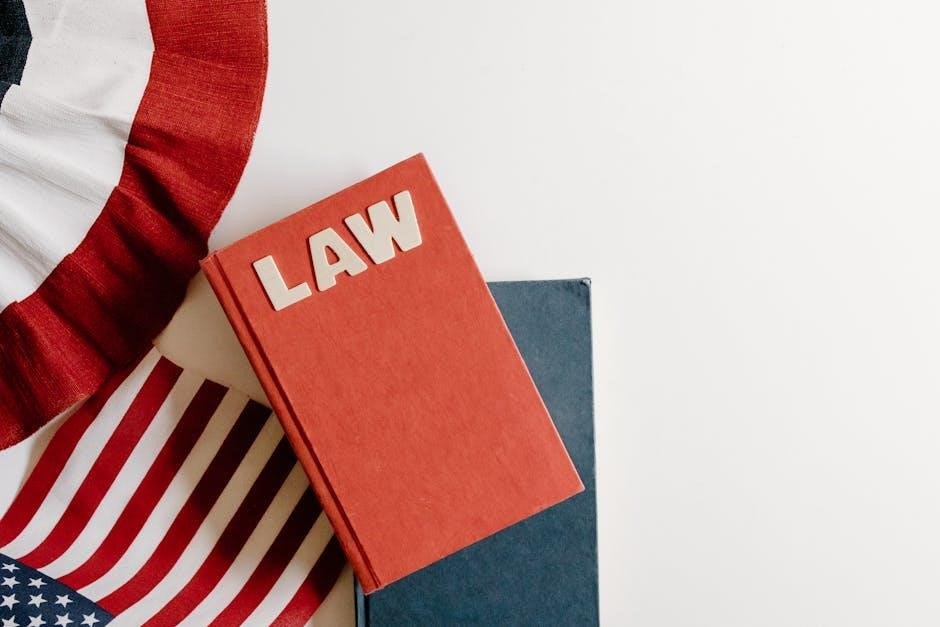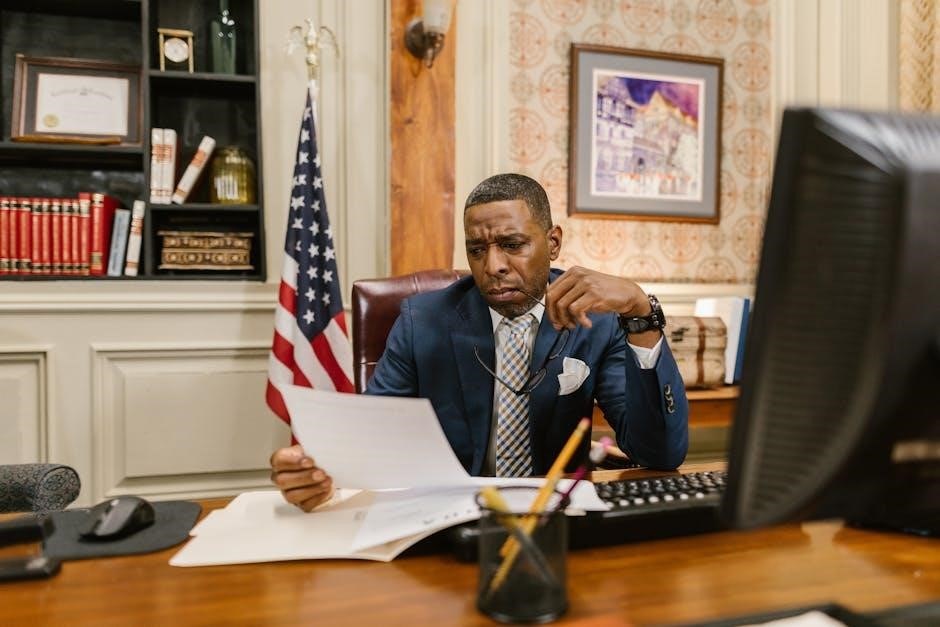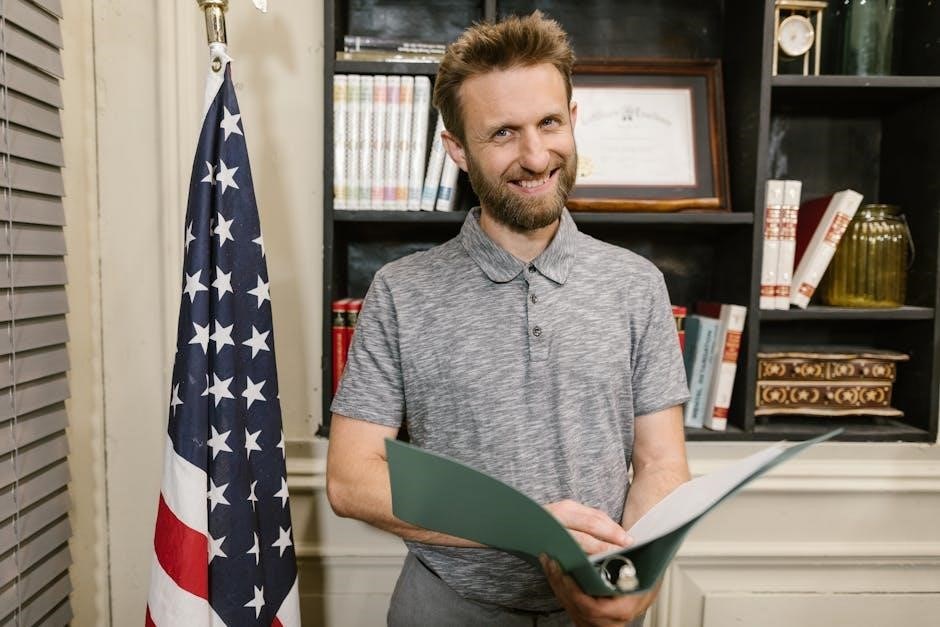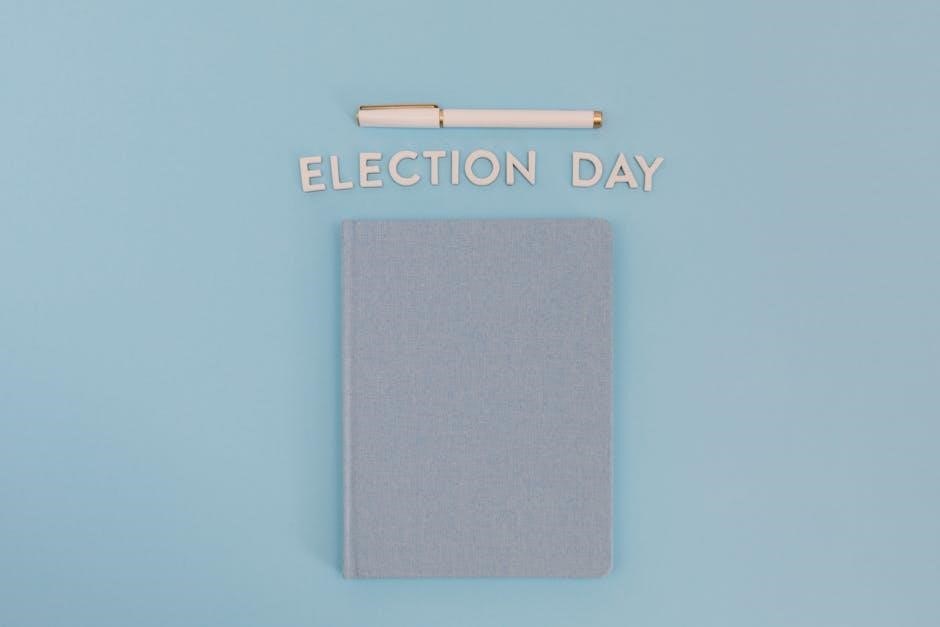Structure of the US Government
The US Government is divided into three branches: legislative‚ executive‚ and judicial. Each branch has distinct roles‚ ensuring a balance of power. Federalism divides authority between federal and state governments‚ promoting cooperation and autonomy. This structure ensures accountability and prevents concentration of power‚ safeguarding individual rights and freedoms.
1.1. The Three Branches of Government
The US Government consists of three branches: the legislative‚ executive‚ and judicial. The legislative branch (Congress) makes laws‚ the executive (President and Cabinet) enforces them‚ and the judicial (Supreme Court) interprets them. This separation ensures checks and balances‚ preventing any single branch from abusing power.
1.2. Federalism: Division of Powers
Federalism divides power between the federal government and state governments. The federal government handles national issues like defense and foreign policy‚ while states manage local matters such as education and transportation. This division promotes efficient governance and allows states to address unique regional needs while maintaining national unity.
1.3. Checks and Balances
The system of checks and balances ensures no single branch of government dominates. The legislative branch can impeach executives‚ the executive can veto laws‚ and the judiciary can declare actions unconstitutional. This prevents abuse of power and maintains equilibrium‚ protecting democratic principles and individual freedoms effectively.
Principles of Democracy
Democracy relies on free elections‚ rule of law‚ and individual rights. It ensures accountability‚ representation‚ and equality‚ fostering a just society where power is distributed fairly among citizens.
2.1. Types of Government Systems
Government systems include federal‚ unitary‚ parliamentary‚ and authoritarian models. Federal systems divide power between central and state governments‚ while unitary systems concentrate authority in a central government. Parliamentary systems feature a prime minister‚ and authoritarian regimes limit public participation and individual freedoms‚ often consolidating power in a single leader or party.
2.2. The Constitution and Its Amendments
The US Constitution‚ adopted in 1788‚ established the framework of the federal government and the relationship between citizens and the state. The Bill of Rights‚ the first ten amendments‚ guarantees fundamental freedoms. Subsequent amendments have expanded rights‚ such as voting for women and African Americans‚ and limited governmental powers.
2.3. Rule of Law and Its Significance
The rule of law ensures everyone is subject to the same legal standards‚ promoting fairness and justice. It prevents arbitrary governance and upholds accountability‚ making it a cornerstone of democracy and societal stability. This principle safeguards individual rights and ensures equal treatment under the law for all citizens.

Policy-Making Process
The policy-making process involves identifying issues‚ drafting proposals‚ and implementing solutions. It requires collaboration between the executive‚ legislative‚ and judicial branches‚ ensuring laws align with societal needs and goals‚ while addressing externalities and public goods effectively.
3.1. How Laws Are Created
Laws are created through a structured process. Bills are introduced in Congress‚ reviewed by committees‚ debated‚ and voted on. If passed‚ they are sent to the President for approval or veto. Congress can override a veto with a two-thirds majority. This process ensures deliberation and representation‚ addressing issues like externalities and public goods.
3.2. Role of Executive‚ Legislative‚ and Judicial Branches
The executive branch‚ led by the President‚ enforces laws. The legislative branch‚ Congress‚ creates laws‚ while the judicial branch interprets them. Together‚ they ensure balance‚ with each branch checking the others’ powers. This system maintains accountability and prevents abuse‚ aligning with the Constitution and safeguarding public interests effectively.
3.3. Examples of Key Policies and Their Impact
Key policies like the New Deal addressed economic crises‚ while the Affordable Care Act expanded healthcare access. Civil Rights Acts combated discrimination‚ fostering equality. These policies have shaped societal structures‚ influencing economic stability‚ healthcare access‚ and social justice‚ with lasting impacts on American life and governance.
Comparative Government
Comparative government examines different political systems worldwide‚ such as the US federal system‚ UK parliamentary model‚ Russian centralized authority‚ and China’s one-party regime‚ highlighting their strengths and challenges.
4.1. US Government vs. Other Countries’ Systems
The US government operates under a federal system with three branches‚ unlike the UK’s parliamentary model or Russia’s centralized authority. China’s one-party regime contrasts sharply with the US’s democratic framework. These comparisons highlight differences in power distribution‚ political representation‚ and governance structures across nations‚ emphasizing unique strengths and challenges each system faces.
4.2. Federal vs. Unitary Systems
A federal system divides power between national and state governments‚ like in the US‚ while a unitary system concentrates authority in a central government‚ as seen in the UK. Federal systems often have dual court systems‚ while unitary systems rely on centralized authority‚ impacting governance efficiency and regional autonomy differently.
4.3. Case Studies: UK‚ Russia‚ and China
The UK operates under a unitary parliamentary system‚ while Russia has a semi-presidential model. China‚ with its one-party system‚ contrasts sharply with the US federal framework. Each system reflects unique historical and cultural contexts‚ influencing governance‚ policy-making‚ and individual freedoms in distinct ways globally.
Civil Rights and Liberties
Civil rights and liberties are protected by key amendments‚ ensuring freedoms like free speech and equal protection. The judiciary plays a crucial role in enforcing these rights‚ maintaining justice and equality for all citizens;
5.1. Key Amendments and Their Meanings
The Constitution’s amendments safeguard fundamental rights. The 13th Amendment abolished slavery‚ while the 14th established citizenship and equal protection. The 19th granted women voting rights‚ shaping civil liberties and equality. These amendments are cornerstone protections for individual freedoms and justice in American society.
5.2. Civil Rights Movements and Their Impact
The Civil Rights Movement of the 1950s and 1960s fought against racial segregation and discrimination. Key events included the March on Washington and the passage of the Civil Rights Act of 1964. These movements led to significant social change‚ advancing equality and justice for marginalized communities‚ leaving a lasting legacy.
5.3. Role of the Judiciary in Protecting Rights
The judiciary plays a crucial role in protecting individual rights by interpreting laws and ensuring they align with the Constitution. Through landmark Supreme Court cases‚ the judiciary has upheld civil liberties‚ overturning discriminatory laws and expanding rights for marginalized groups‚ ensuring justice and equality under the law.

Economic Policy and Government
The government plays a key role in the economy by addressing market failures‚ regulating industries‚ and providing public goods. It uses tools like taxation‚ subsidies‚ and regulations to promote economic stability and protect consumer interests‚ ensuring equitable growth and resource allocation.
6.1. Public Goods and Externalities
Public goods‚ like national defense‚ are non-excludable and non-rivalrous‚ benefiting everyone. Externalities‚ such as pollution‚ impose costs on society. Governments address these through policies like taxes‚ subsidies‚ and regulations to correct market failures and promote efficient resource allocation for public benefit.
6.2. Role of Government in the Economy
The government plays a crucial role in regulating economic activity‚ redistributing wealth‚ and stabilizing markets. It enacts policies to correct market failures‚ protect consumer rights‚ and promote public welfare. Tools like taxes‚ subsidies‚ and regulations ensure fair competition and address social inequities‚ fostering sustainable economic growth and stability.
6.3. Examples of Government Intervention
Government intervention includes policies like minimum wage laws‚ environmental regulations‚ and taxes to correct market failures. Public goods‚ such as infrastructure‚ are provided to ensure universal access. Subsidies support industries‚ while anti-trust laws prevent monopolies‚ promoting fair competition and protecting consumer interests.

National Security and Government
National security involves protecting the nation from threats‚ ensuring stability‚ and maintaining sovereignty. It includes military defense‚ intelligence gathering‚ and strategic policies to safeguard citizens and interests.
7.1. Structure of National Security Council
The National Security Council (NSC) is a key institution advising the President on security issues. It includes senior officials like the Vice President‚ Secretary of State‚ and Defense Secretary. The NSC coordinates policies across agencies to address threats and maintain national interests‚ ensuring a unified approach to security challenges.
7.2. Role of Intelligence Agencies
Intelligence agencies play a vital role in gathering and analyzing data to support national security decisions. They provide critical insights to policymakers‚ helping to identify threats and opportunities. Their work is essential for maintaining national safety and advancing foreign policy objectives effectively.
7.3. Major National Security Policies
Major national security policies focus on protecting the nation from external threats through strategies like counterterrorism‚ cybersecurity‚ and military defense. These policies aim to maintain global stability‚ safeguard economic interests‚ and ensure the country’s sovereignty. Effective implementation is crucial for long-term national safety and international cooperation.
Public Administration
Public administration involves managing government policies and programs. Bureaucracy plays a key role in implementing laws and regulations. It ensures efficient governance and addresses societal challenges effectively while maintaining accountability.
8.1. Bureaucracy and Its Functions
Bureaucracy is a hierarchical structure within governments responsible for implementing policies. It ensures consistency‚ efficiency‚ and adherence to regulations. Functions include administrative support‚ policy execution‚ and maintaining public order. Bureaucrats specialize in specific areas‚ providing expertise and continuity in governance‚ essential for effective public service delivery and accountability.
8.2. Administrative Law and Regulations
Administrative law governs government agencies’ operations‚ ensuring accountability. It includes rules and procedures for implementing policies. Judicial review ensures laws align with constitutional and statutory frameworks. This system balances governance efficiency with individual rights protection‚ maintaining public trust and order through structured decision-making processes and regulatory enforcement.
8.3. Challenges in Public Administration
Public administration faces challenges like bureaucratic inefficiencies‚ political interference‚ and resource constraints. Balancing public expectations with policy implementation is complex. Ethical dilemmas and transparency issues further complicate governance. Addressing these challenges requires effective leadership‚ streamlined processes‚ and strong accountability mechanisms to ensure efficient and equitable service delivery.
Environmental Policy
Environmental policy focuses on laws and regulations to protect natural resources and address climate change. Governments enforce standards‚ promote sustainability‚ and engage in global agreements to ensure ecological balance.
9.1. Key Environmental Laws and Regulations
Key environmental laws include the Clean Air Act‚ Clean Water Act‚ and Endangered Species Act. These regulations aim to reduce pollution‚ protect ecosystems‚ and promote sustainable development. They establish federal standards‚ enforce penalties for violations‚ and encourage public participation in environmental conservation efforts nationwide.
9.2. Role of Government in Environmental Protection
The government plays a crucial role in enforcing environmental regulations‚ funding conservation initiatives‚ and promoting sustainable practices. Federal and state agencies collaborate to address climate change‚ protect natural resources‚ and ensure public health. Their efforts include policy implementation‚ international cooperation‚ and supporting education to foster environmental stewardship and innovation.
9.3. Global Environmental Agreements
Global environmental agreements bring nations together to address climate change‚ biodiversity loss‚ and resource depletion. Agreements like the Paris Agreement and Kyoto Protocol establish frameworks for reducing emissions and promoting sustainable practices. These treaties require cooperation‚ accountability‚ and innovative solutions to protect the planet for future generations while balancing economic and environmental needs.
Ethics in Government
Ethics in government ensure accountability‚ transparency‚ and fairness. They prevent corruption‚ promote integrity‚ and build public trust in decision-making processes and institutions.
10.1. Corruption and Its Impact
Corruption undermines government legitimacy‚ distorts policies‚ and erodes public trust. It leads to inequality‚ inefficiency‚ and misuse of resources‚ hindering economic growth and social development. Addressing corruption requires strong accountability mechanisms and ethical frameworks to ensure transparency and fairness in governance.
10.2. Accountability Mechanisms
Accountability mechanisms ensure transparency and responsibility in governance. These include oversight bodies‚ audits‚ and anti-corruption laws. They promote integrity‚ prevent abuse of power‚ and build public trust. Effective mechanisms also involve citizen participation and a free press to monitor government actions and hold officials accountable.
10.3; Ethical Decision-Making in Governance
Ethical decision-making in governance involves applying moral principles to ensure fairness‚ transparency‚ and accountability. Leaders must balance public interest with individual rights‚ acting with integrity and transparency. Tools like codes of conduct and ethical guidelines help maintain trust and accountability‚ fostering responsible governance and long-term societal benefits.
Global Governance
Global governance involves international cooperation and organizations like the United Nations to address global issues. It ensures collective action on challenges such as climate change and economic inequality.
11.1. International Relations and Organizations
International relations involve interactions between nations‚ guided by organizations like the United Nations. These entities promote diplomacy‚ peacekeeping‚ and cooperation‚ addressing global challenges. They play a crucial role in shaping policies‚ ensuring stability‚ and fostering collaboration on issues like human rights and economic development.
11.2. Role of the United Nations
The United Nations plays a crucial role in maintaining global peace and security through peacekeeping missions and mediations. It promotes human rights‚ fosters international cooperation‚ and addresses challenges like sustainable development‚ climate change‚ and humanitarian crises‚ serving as a platform for dialogue and collective action among nations.
11.3. Global Challenges and Governance Responses
Global challenges like climate change‚ pandemics‚ and economic inequality require coordinated governance responses. International organizations and agreements address these issues through policy frameworks‚ fostering collaboration and resource sharing. Effective governance ensures sustainable solutions‚ mitigates risks‚ and promotes equity‚ adapting to evolving global needs and crises.

Study Guide and Review
This section provides key terms‚ practice questions‚ and additional resources for comprehensive review. It aids in understanding major concepts‚ reinforcing learning‚ and preparing for assessments effectively.
12.1. Key Terms and Concepts
- Public Goods: Non-excludable and non-rivalrous goods‚ like national defense‚ provided by the government.
- Externalities: Economic side effects impacting third parties‚ addressed through regulation.
- Executive Order: Presidential directive bypassing Congress to manage federal operations.
- Federalism: Division of power between federal and state governments.
- Judicial Review: Supreme Court’s authority to invalidate laws contradicting the Constitution.
- Bicameral Legislature: Two-chamber system ensuring balanced law-making.
- Checks and Balances: Mechanisms preventing power concentration in one branch.
- Amendments: Constitutional changes reflecting evolving societal needs.
- Civil Liberties: Fundamental rights protecting individual freedoms.
- Executive Agreements: International deals made without Senate approval.
12.2. Practice Questions and Answers
- Q1: Name the three branches of the US Government.
A: Legislative‚ Executive‚ and Judicial. - Q2: What is federalism?
A: Division of power between federal and state governments. - Q3: How can the President pass a law without Congress?
A: Through an executive order. - Q4: What is judicial review?
A: The Supreme Court’s power to declare laws unconstitutional. - Q5: What are civil liberties?
A: Fundamental rights protecting individual freedoms.
12.3. Additional Resources for Further Study
For deeper understanding‚ explore the following resources:
– Government Study Guides with detailed outlines.
– Crash Course: US Government video series.
– Quizlet Flashcards for key terms.
– Document Analysis Worksheets for primary sources.
